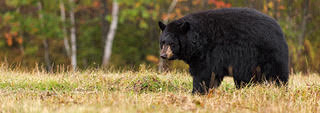Reviving Apple Trees
By Glen Wunderlich
Charter Member Professional Outdoor
As baiting and feeding deer have become unlawful in Michigan’s Lower Peninsula, more hunters have moved toward the use of food plots, as a viable means to attract and hold deer on hunting land. Although hunters with disabilities who meet specific requirements can still use bait, the practice is being curtailed more and more, as a means to minimize the spread of Chronic Wasting Disease. Hunters looking for an edge and have access to private land hunting may want to consider reviving old apple trees as a viable option to baiting.
Many existing farms and abandoned properties have overgrown orchards or even lone apple trees sprinkled about and with a bit of timely maintenance can become a focal point of early season wildlife activity.

Overgrown Red Delicious Still Producing
It may take a few years to get trees to bear fruit prolifically, but a good time to begin is now, while the trees are still in full leaf. Although pruning is best done while trees are dormant, leaves or a lack thereof, will show a good place to start by identifying dead or decayed branches and removing them.
To do so, it is wise to invest in a good pole saw that allows pruning without the use of a ladder. Such saws typically incorporate a pruning device actuated by means of an attached rope for smaller branches, which by the way are problematic to cut with a saw. The sharp blade of the pruner makes for a clean cut, thus minimizing the chance for insects and disease to enter at the wound. Just insure that all dead-wood pruning is performed as close to the living tissue as possible.
Look for dead limbs or branches and remove them first. Also, eliminate branches that either rub on other branches or will do so in the near future. Fruit trees are different than other trees in that they do best if the center of the tree is open, as opposed to maintaining a central leading trunk. Apples are typically produced on the youngest growth, so identify these branches now and leave the new growth alone.
Apple trees do well with lots of direct sunlight. If there is competition with shrubs, vegetation or other nearby trees, remove undesirables.

The apple tree was given new life with the removal of a line of spruce trees (stumps visible)
For the most part, however, substantial pruning is best done in springtime after the last frost and before blooming begins. Remove no more than one third of the upper branches of the canopy to reduce the height and to let more valuable sunlight into the tree. It may take a few years to complete the job, but taking too many of the branches off at one time can weaken a tree’s ability to survive.
Finally in the spring only – never in the fall – fertilize the perimeter of the drip line, which is a circular line directly beneath the outermost tips of the branches with three pounds of 6-24-24 fertilizer. (The same fertilizer is great for clover and alfalfa food plots, as well.)
If you’d like to create some rabbit habitat, make a pile with the branches. Not only will rabbits be safe from predators within the makeshift hut, but they’ll feed on the succulent bark.

Old Granny Smith tree clingiing to life and still producing on the only living limb (the curved one going to the upper right corner of the pic)






